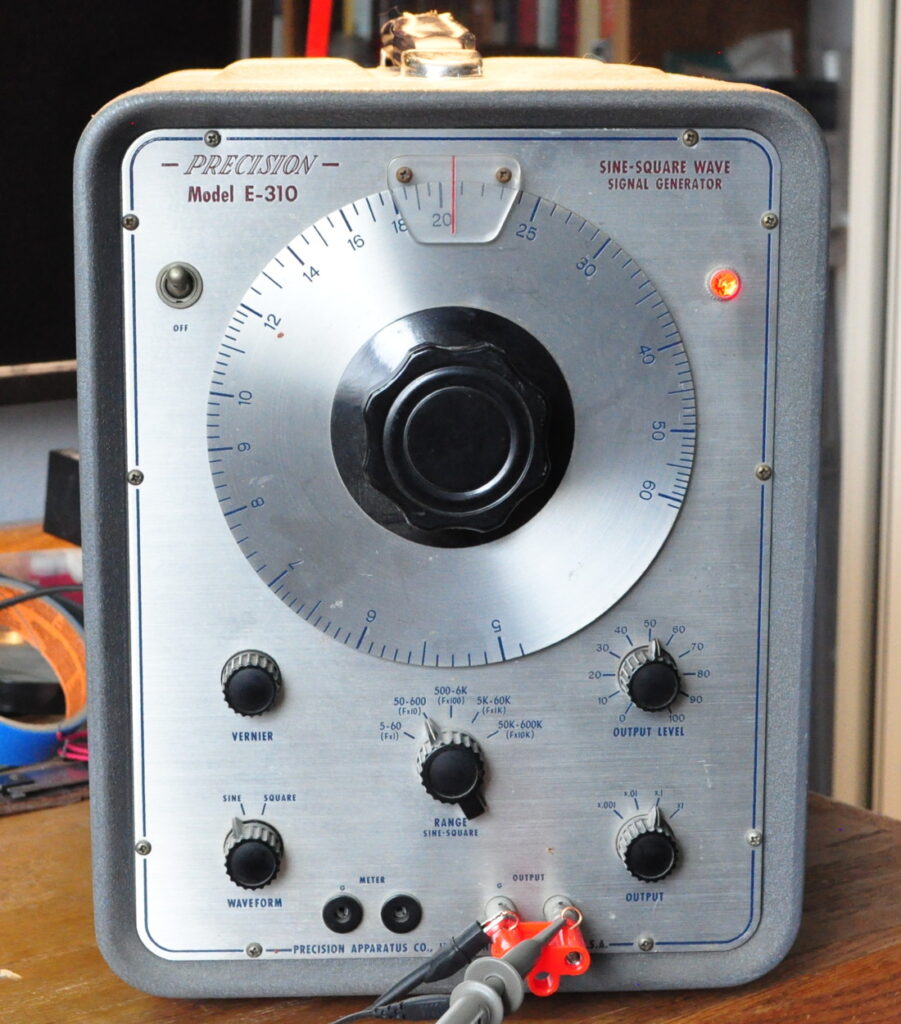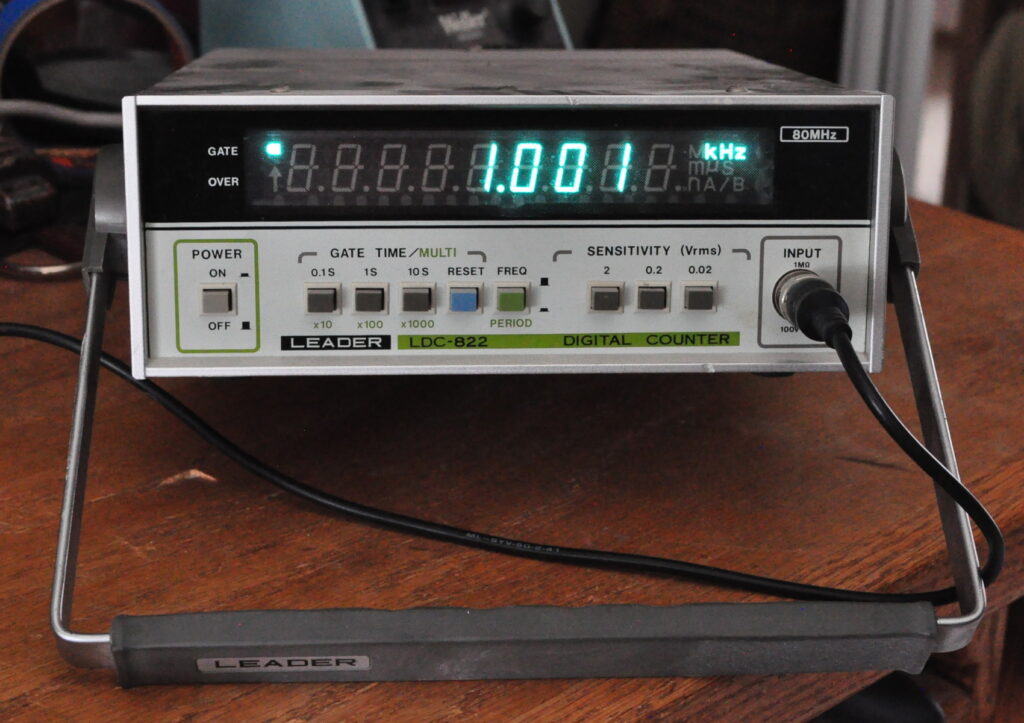It never ceases to amaze me how much test equipment I have seemed to have accumulated in the last 40 years or so. And some of it has been largely overshadowed by the continuing march of technology. It seems that everything now is so feature packed that lots of the old equipment is (nearly) totally obsolete.
When I started tinkering with electronics almost 50 years ago there were a few things that really set you apart if you had them in your workshop. On my eternal wish list back in the 1970s were a Vacuum Tube Volt Meter (VTVM) primarily for its very high input impedance, a basic oscilloscope (a dual channel scope was viewed as out of reach), and a good signal generator that went to at least 1MHz for testing audio equipment and aligning the IF sections of tube radios.
Of course I had a small multimeter. I think it was 10,000 Ω/Volt kit unit purchased from RadioShack. This was back when they were called VOMs for Volt-Ohm Meter. And I had cobbled together a sine wave signal generator that could output about four fixed tones. But there really wasn’t much in the way of real test equipment in my basement workshop. As I started experimenting with digital circuits I did cobble together a few other things but most was homemade or rebuilt castoffs.
Fast forward to to today and that test equipment I used to dream about all seems like a collection of museum pieces. By those standards the Fluke 179 multimeter and the inexpensive Rigol DS-1054Z four channel oscilloscope that see most of my daily use seem like equipment out of a science fiction movie. Along the way I’ve picked up some equipment that was very useful at the time but has been almost completely overshadowed today. A good example of this is audio signal generators.
My first signal generator (which I still have) was a used Precision E-310 sine and square wave generator. This is one of the original E-310s sold by the Precision Apparatus Company of Long Island, NY before they were bought out by B+K in 1961. When I first acquired this unit many years ago, I thought I’d hit a gold mine. This is a totally vacuum tube unit which would fit in nicely on the set of any 1950s science fiction movie.
This is how it looked just this morning as I was checking it’s operation. It is in need of a full calibration as some of the frequency scales are a little off. But today there’s not a lot of need for high precision in the dial placement. In truth, I haven’t used this signal source for testing in several years. The last time was when I needed a second source so that I could check the intermodulation performance of an amplifier. And the inherent noise and microphonics of this unit made that measurement difficult.
Today, if you want a signal generator for audio work, you can get a Wien bridge unit (complete with big dial) for about $65 USD, or a small DSS unit for about $20 USD, or simply use the cell phone in your pocket with a free app. And all of them will have much better performance than this old vacuum tube unit. Don’t get me wrong, I still love this piece of equipment; in spite of its noisiness, microphonic nature, and other behavioral quirks. But the little Wien bridge Tenma 72-455 I bought about 20 years ago gets used for almost all of my amplifier work these days. And even it is more than a little outmoded.
The other piece of equipment I was looking at this morning was a bench top frequency counter; a Leader LDC-822. These were made in the late 1970s and early 1980s. They were a common sight in repair shops dealing with radio repair and early digital equipment.
This unit is truly an anachronism today. Again, this was a great piece of equipment in its day. If you’re looking to measure frequency or pulse widths of square, sine, or other periodic waves, this is a great resource up to 80MHz. However, today, the function of frequency/pulse measurement has found its way into lots of other equipment.
As a case in point, the inexpensive DS-1054Z mentioned earlier will perform the exact same functions as this unit (and more) up to 50MHz with greater precision. And this morning, this unit and my DS-1054Z agreed on the frequency readings down to the LSB of this instrument. In fact, even my humble little Fluke 179 multimeter will measure frequency up to 100kHz, making it ideal all by itself for audio equipment testing. So this unit does still fill a niche between 50MHz and 80MHz making it somewhat useful for some shortwave radio work. But it mostly collects dust these days.
There are some other things sitting on my equipment shelf that really have completely fallen out of use. These include a Fluke 8010 bench top multimeter (totally overshadowed by the Fluke 179) and a Leader LMV-87 AC Millivoltmeter which in currently in need of repair. The 8010 was a good meter in its day, especially in repair shops and educational environments, but even the inexpensive Fluke 107 for less than $100 USD is a much better meter today. The only benefit of the old AC millivoltmeters over the 107 is that they will read directly in dB. But thats not much of an advantage especially with modern auto ranging meters. And this is to say nothing of the numerous other pieces of speciality hand held equipment that litter my work space. Most of which only get looked at maybe once a year when I check to make sure there are no leaking batteries.
I keep telling myself that I’m going to find homes for much of this miscellaneous equipment, but I never seem to get around to it. The truth is most people don’t want most of it for the same reasons I don’t use it. These functions are largely right under my fingertips on the equipment I do use most often.
I’d like to hear what kinds of old test equipment other people have hiding in closets or sitting on dusty shelves. Maybe we could start our own museum.
As always, questions and comments are welcome.



The best all-in-one that I ever used was the company owned Fluke Scope Meter. Handheld full feature 2 channel scope and DMM all in one unit. You name it did it! Was able to observe waveforms and FFTs of 600VAC power systems, all the way down to millivolts and microamps of sensing systems. An accessory CT probe allowed me to observe hundreds of amps of current. It would be nice to have a personal one, but it would be a very pricey piece of gross overkill for audio work.
California Scientific multimeter. Pixie tube display. This thing is still the most accurate voltmeter in my possession. Not too big… standard bench test equipment size of the mid 1970s. I don’t plan to let go of this thing. Old Heathkit signal generator is different. I can’t imagine getting rid of it yet I’ll probably never use it again. I might be a hoarder 😎
To some extent, aren’t we all hoarders? 😉
Yep, between my Rigol scope (measure and see anything you want by pushing a few buttons), and 3 DMMs (Fluke, Klein, Beckman), I have a complete set of test equipment. I have the AF generator app on my shop tablet – very useful device. Like you, I have a bunch of older stuff ( some of it older than me – and I’m pushing 70 these days) that should be scrapped. But, like many folks, sentimental reasons keep me from disposing of it, even though it would free up much desired bench and storage space.
I have an AVO 7 and an AVO 8. Both work okay but need some attention. The AVO 8 still has it’s “leather” case. I don’t use them, but I would not like to part with them.
Many years ago (early 70’s) I worked for Hiwatt Amplifiers as a bench wireman. The test engineers used AVO’s.
Enjoyed reading this one. I’m still amazed at times by the functionality of my Fluke 87V, which I saved up to purchase. I’d consider a quality multimeter a necessity for the hobby of amp building.
That Precision E-310 is a very attractive unit.